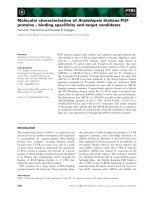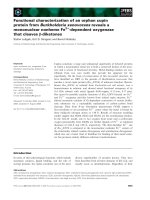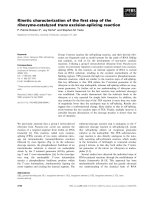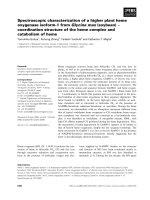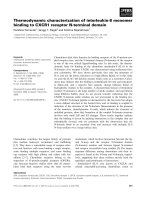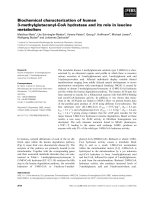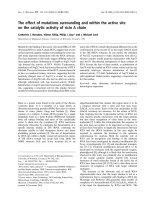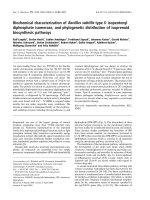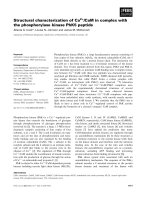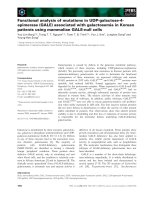Báo cáo khoa học: Systematic characterization of mutations in yeast acetohydroxyacid synthase doc
Bạn đang xem bản rút gọn của tài liệu. Xem và tải ngay bản đầy đủ của tài liệu tại đây (490.44 KB, 10 trang )
Systematic characterization of mutations in yeast acetohydroxyacid
synthase
Interpretation of herbicide-resistance data
Ronald G. Duggleby, Siew Siew Pang, Hongqi Yu* and Luke W. Guddat
Department of Biochemistry and Molecular Biology, The University of Queensland, Brisbane, QLD 4072, Australia
Acetohydroxyacid synthase (AHAS, EC 4.1.3.18) catalyses
the first step in branched-chain amino acid biosynthesis and
is the target for sulfonylurea and imidazolinone herbicides,
which act as potent and specific inhibitors. Mutants of the
enzyme have been identified that are resistant to particular
herbicides. However, the selectivity of these mutants towards
various sulfonylureas and imidazolinones has not been
determined systematically. Now that the structure of the
yeast enzyme is known, both in the absence and presence of a
bound herbicide, a detailed understanding of the molecular
interactions between the enzyme and its inhibitors becomes
possible. Here we construct 10 active mutants of yeast
AHAS, purify the enzymes and determine their sensitivity to
six sulfonylureas and three imidazolinones. An additional
three active mutants were constructed with a view to
increasing imidazolinone sensitivity. These three variants
were purified and tested for their sensitivity to the imida-
zolinones only. Substantial differences are observed in the
sensitivity of the 13 mutants to the various inhibitors and
these differences are interpreted in terms of the structure of
the herbicide-binding site on the enzyme.
Keywords: acetohydroxyacid synthase; herbicide inhibition;
herbicide-resistance mutations; imidazolinone; sulfonylurea.
The inability of higher animals to synthesize branched-chain
amino acids makes these compounds essential in the diet. In
contrast, plants and many microorganisms do not require a
supply of these amino acids and contain all of the enzymes
for their biosynthesis (Fig. 1A). As a result, these enzymes
have attracted attention as potential targets for inhibitors to
be used as herbicides and as antibiotics [1,2].
To date, the only enzyme target for which practical
inhibitors have been developed is acetohydroxyacid syn-
thase (AHAS; EC 4.1.3.18). This enzyme is inhibited by
several families of compounds [1] and two of these families
(Fig. 2), the sulfonylureas [chlorimuron ethyl (CE),
chlorsulfuron (CS), metsulfuron methyl (MM), sulfometu-
ron methyl (SM), tribenuron methyl (TB) and thifensulfu-
ron methyl (TF)] and the imidazolinones [imazapyr (IP),
imazaquin (IQ) and imazethapyr (IT)], are used extensively
as commercial herbicides.
The inhibitory herbicides do not resemble the substrates
or products of the AHAS reaction (Fig. 1B). Neither do
they resemble the organic cofactors required by AHAS,
thiamine diphosphate (ThDP) and FAD. Thus, it has been
suggested that these herbicides are Ôextraneous site inhibi-
torsÕ [3] that do not occupy the active site. Therefore, it
could be anticipated that mutations could arise that
diminish herbicide binding without abolishing the catalytic
capacity of AHAS.
This expectation has been realized in field isolates and
in mutants generated in vitro. The most extensive series of
these are those reported for yeast AHAS [4] in which 10 sites
were located where spontaneous mutation results in SM
resistance. At some sites, almost any amino acid substitution
results in resistance while at others only a few substitutions
are tolerated. Studies of AHAS from other species have
identified additional herbicide-resistance mutation sites
[5–9] and have also confirmed some of those observed for
the yeast enzyme. The natural amino acid at most of these
sites is strongly conserved in AHAS across plant, fungal and
bacterial species [1], suggesting that these residues play
important roles. However, the fact that organisms carrying
mutations at these sites are viable but herbicide resistant
shows that the variants must be active. Indeed, detailed
in vitro studies in this laboratory of selected variants [7–10]
have shown that most have no major alterations in activity
or the kinetic properties towards substrate or cofactors.
Until recent work from this laboratory [11,12], no three-
dimensional structure of any AHAS had been determined
Correspondence to R. G. Duggleby, Department of Biochemistry and
Molecular Biology, The University of Queensland, Brisbane,
QLD 4072, Australia.
Fax: + 617 33654699, Tel.: + 617 33654615,
E-mail:
Abbreviations: AHAS, acetohydroxyacid synthase; CE, chlorimuron
ethyl; CS, chlorsulfuron; IP, imazapyr; IQ, imazaquin; IT, imazetha-
pyr; MM, metsulfuron methyl; SM, sulfometuron methyl; TA,
branched-chain amino acid transaminase; TB, tribenuron methyl;
TF, thifensulfuron methyl; ThDP, thiamine diphosphate.
Enzymes: acetohydroxyacid synthase (EC 4.1.3.18); ketol-acid
reductoisomerase (EC 1.1.1.86); dihydroxy-acid dehydratase (EC
4.2.1.9); branched-chain amino acid transaminase (EC 2.6.1.42);
isopropylmalate synthase (EC 4.1.3.12); isopropylmalate isomerase
(EC 4.2.1.33); isopropylmalate dehydrogenase (EC 1.1.1.85).
*Present address: Department of Chemistry and Biochemistry,
Arizona State University, Tempe, AZ 85287-1604, USA.
Note: a web site is available at />(Received 17 March 2003, revised 21 April 2003,
accepted 15 May 2003)
Eur. J. Biochem. 270, 2895–2904 (2003) Ó FEBS 2003 doi:10.1046/j.1432-1033.2003.03671.x
and conjectures about the structure of the herbicide-binding
site were based on homology models [5,6] or theoretical
calculations [13,14]. Our structure of yeast AHAS with
bound CE [12] has provided the first experimental basis for
understanding the detailed molecular interactions between a
sulfonylurea herbicide and the residues involved in herbicide
resistance. Although it would be desirable to know the
structure of a plant AHAS, diffraction quality crystals have
not been produced thus far. However, the structure of yeast
AHAS shows that every residue at which mutation in plant
AHAS results in herbicide resistance is in close proximity to
CE. Therefore, we believe that the yeast enzyme represents a
very good model system for understanding plant AHAS.
The structure reveals that the enzyme is a homodimer
with each subunit composed of three domains of similar
size, designated a, b and c. Herbicide-resistance mutations
are spread through all three domains (Fig. 3A) but the
protein folds so as to bring these together in a single region
at the subunit interface and define a plausible herbicide-
binding site (Fig. 3B) at the entrance of a channel leading to
the active site. CE is inserted into this channel with the ring
that is attached to the nitrogen atom of the sulfonylurea
bridge (hereafter referred to as the ÔN-ringÕ)andtheethyl
substituent projecting inwards, while the ring that is
attached to the sulphur atom of the sulfonylurea bridge
(the ÔS-ringÕ) lies across the top of the channel.
CE is unique amongst the sulfonylureas shown in Fig. 2
in that it is the only one with an ethylated carboxyl group
attached to the S-ring. The other sulfonylureas have a
smaller substituent, either a methylated carboxyl or chlorine
atom in the case of CS. Since this side chain of CE makes
important interactions with the protein, it is possible
that the binding mode of other sulfonylureas differs from
that of CE.
Fig. 1. Pathway of branched-chain amino acid biosynthesis (A) and the
reaction catalysed by AHAS (B). Enzyme names are shown in bold
italics, abbreviated as follows: AHAS, acetohydroxyacid synthase (EC
4.1.3.18); KARI, ketol-acid reductoisomerase (EC 1.1.1.86); DHD,
dihydroxy-acid dehydratase (EC 4.2.1.9); TA, branched-chain amino
acid transaminase (EC 2.6.1.42); IPMS, isopropylmalate synthase (EC
4.1.3.12); IPMI, isopropylmalate isomerase (EC 4.2.1.33); and IPMD,
isopropylmalate dehydrogenase (EC 1.1.1.85). (B) The reaction cata-
lysed by AHAS.
Fig. 2. Structures of the sulfonylurea and imidazolinone herbicides. The
rings of the sulfonylureas that are connected to the sulphur and
nitrogen atoms of the sulfonylurea bridge are referred to in the text as
the ÔS-ringÕ and ÔN-ringÕ regions of the molecule, respectively.
2896 R. G. Duggleby et al. (Eur. J. Biochem. 270) Ó FEBS 2003
The binding orientation of imidazolinones is even more
uncertain because they differ substantially in structure from
the sulfonylureas. It should be recognized in this context
that there is very little published information in the literature
that would allow mapping of the amino acids with which
imidazolinones interact. Indeed, the literature on the effects
of mutation at each resistance site on sensitivity to all
herbicides is very sparse and in only a few cases [7–10] has
the specificity towards a range of different herbicides been
determined. Therefore, we have now undertaken a system-
atic program of mutagenesis of residues in the proposed
herbicide-binding site of yeast AHAS, and characterization
of the inhibition by a series of six sulfonylurea and three
imidazolinone herbicides.
Materials and methods
Mutagenesis
The expression plasmids for yeast AHAS catalytic and
regulatory subunits were as described previously [15].
Methods for bacterial culture and DNA manipulation
generally followed standard procedures [16]. Mutations
were introduced by PCR using the megaprimer method [17].
Oligonucleotides were designed to introduce or remove a
restriction enzyme recognition site to aid identification of
mutated DNA. All constructs were tested by diagnostic
restriction enzyme digestion and the mutations were con-
firmed by DNA sequencing using the Prism Ready Dye
Terminator Cycle Sequencing Kit and DNA Sequencer
373A (Perkin-Elmer Applied Biosystems).
Protein purification and enzyme assays
The hexahistidine-tagged catalytic and regulatory subunits
of AHAS were purified by immobilized metal affinity
chromatography as described previously [15,18]. Mutant
forms of the catalytic subunit were purified using an
identical procedure. The purity of the proteins obtained
was assessed by SDS/PAGE [19]. Protein concentrations
were determined using the bicinchoninic acid method
[20].
AHAS activity was measured at 30 °Cin1
M
potas-
sium phosphate buffer pH 7.0 containing 1 m
M
ThDP,
10 m
M
MgCl
2
,10l
M
FAD and pyruvate concentrations
as required, as described previously [15,18]. Stock solu-
tions of inhibitors were prepared in 1
M
Tris/H
2
SO
4
pH 9.0 for the imidazolinones and in 0.1
M
Tris/H
2
SO
4
pH 9.0 for the sulfonylureas. These were added to
reaction mixtures to give the desired final inhibitor
concentrations, together with additional 1
M
Tris/H
2
SO
4
pH 9.0 to maintain a final concentration of 0.1
M
for
the imidazolinone inhibition assays. Inhibition experi-
ments were conducted with a pyruvate concentration
close to the K
m
value of each individual mutant
enzyme that was used. Where indicated, dimethylsulf-
oxide was added, usually to give a final concentration of
15% (v/v).
Preparation of FAD-free AHAS
When FAD-free AHAS was required for particular
experiments, this cofactor was removed from the
Fig. 3. Location of herbicide-resistance muta-
tions in yeast AHAS. (A) Positions of muta-
tion sites in the amino acid sequence, coloured
green, blue and pink/purple for the a-, b-and
c-domains, respectively. (B) Positions of
mutation sites in the three-dimensional struc-
ture. The location of CE was determined from
the three-dimensional structure of the
AHAS–CE complex [12]; PDB accession code
1N0H. The backbone Ca trace in the vicinity
is coloured as in panel A. Atoms in residues
that were mutated in the present study are
shown as balls, while CE is shown as a stick
model.
Ó FEBS 2003 AHAS mutations affecting herbicide sensitivity (Eur. J. Biochem. 270) 2897
preparation by adsorption using activated charcoal. Acti-
vated charcoal (ICI United States Inc.) was pretreated by
washing several times in 0.2
M
potassium phosphate
pH 6.0 containing 1 m
M
dithiothreitol, and resuspended
in the same buffer to give a concentration of 25% (w/v).
The activated charcoal was added to the AHAS protein
solution (% 3mgÆmL
)1
) to give a concentration of 0.5%,
mixed and incubated on ice for % 5 min. The activated
charcoal was then removed by centrifugation. Usually the
treatment had to be repeated several times to remove all
FAD. The extent of cofactor removal was tested by
measurement of the residual enzymatic activity with no
added FAD.
Spectroscopy
Absorbance spectra of wild-type AHAS and the M354V
mutant enzyme were collected using a SpectraMax 250
(Molecular Devices) microplate spectrophotometer at room
temperature. The enzyme solutions were diluted to concen-
trations of 2.6–3.0 mgÆmL
)1
, using buffer containing 0.2
M
potassium phosphate (pH 6.0), 10 l
M
FAD and 1 m
M
dithiothreitol. The diluted protein solutions were clarified
by centrifugation. Absorbance spectra were recorded from
330 to 510 nm. The protein spectra were corrected for that
of the buffer.
For MS of herbicides, they were diluted to a concentra-
tion of 0.1 or 1 m
M
in 0.1% acetic acid solution. The diluted
samples were analysed using API 165 LC/MS System (PE
SCIEX). Full scan data were acquired over the mass/charge
range from 200 to 600, with a step size of 0.2 atomic mass
units and a dwell time of 0.5 ms.
Kinetic data analysis
Kinetic data were analysed by nonlinear regression using
the programs
GRAPHPAD PRISM
and
INPLOT
4,
SIGMAPLOT
,or
GRAFIT
. The Michaelis–Menten equation (Eqn 1) was fitted
to substrate and FAD saturation curves, while inhibition
curves were analysed initially using a partial inhibition
model (Eqn 2). If this initial analysis indicated that the
residual activity (v
1
) at a saturating inhibitor concentration
is not significantly greater than zero, the data were
reanalysed with v ¼ 0.
v ¼ V
m
½A=ðK
m
þ½AÞ ð1Þ
v ¼ v
1
þðv
0
À v
1
Þ=ð1 þ½I=K
i
Þð2Þ
Results
Choice of mutations
Falco et al. [4] described a series of spontaneous mutations
of yeast AHAS that result in resistance to the sulfonylurea,
SM. These mutations occur at 10 sites and further SM-
resistant mutants were identified by deliberate mutagenesis
at these 10 sites. We have reproduced one of the sponta-
neous substitutions at each of these 10 residues, as follows:
G116S, A117V, P192S, A200V and K251T in the a-domain;
M354V and D379N in the b-domain; and V583A, W586L
and F590L in the c-domain. Henceforth these variants will
be designated the ÔFalco mutationsÕ. We expected all of these
variants to be resistant to SM but their sensitivity to
other sulfonylureas, and to imidazolinones, had not been
determined.
Mutations at three additional sites (L119, S194 and
G657), located in the herbicide-binding site (Fig. 3), were
made. Ott et al. [5] described the mutations M124E and
M124I of Arabidopsis thaliana AHAS that both result in
resistance to the imidazolinone IT, as well as to the
sulfonylurea SM for M124I only. In yeast AHAS, the
equivalent residue is L119 and this was mutated to
methionine as found in wild-type A. thaliana AHAS. It
was hoped that this mutant would show increased sensitivity
to imidazolinones and was tested with this family of
herbicides only. For similar reasons we mutated S194 to
arginine as found at the equivalent position (R199) in wild-
type A. thaliana AHAS; Ott et al. [5] had found IT
resistance when R199 in A. thaliana AHAS was mutated
to alanine or glutamate. As well as these two a-domain
variants, we made the G657A mutant in the c-domain. In
plant AHAS, the equivalent residue is a serine and mutation
to larger residues (asparagine, threonine or phenylalanine)
results in imidazolinone resistance [8,9].
Mutagenesis, enzyme purification and activity
Each mutation was introduced successfully by overlap
extension PCR [17], cloned into the expression vector
described previously [15], and the base changes confirmed
by DNA sequencing (data not shown). Each protein was
expressed and purified and in most cases was shown to be
close to purity by SDS/PAGE (Fig. 4). The specific activity
of each purified protein was determined (Tables 1–3); all
proteins are active and in most cases the specific activity is
Fig. 4. SDS/PAGE of purified wild-type yeast
AHAS and its mutants. The samples in the
lanes are: 1, Wild-type; 2, G116A; 3, A117V; 4,
M119L; 5, P192S; 6, S194R; 7, V200A; 8,
K251T; M, molecular mass markers (116, 66,
45, 35, 25 and 18 kDa); 9, M354V; 10,
D379N, 11, V583A; 12, W586L; 13, F590L;
14, G657A.
2898 R. G. Duggleby et al. (Eur. J. Biochem. 270) Ó FEBS 2003
not substantially lower than that of the wild-type. Four of
the variants (L119M, D379N, W586L and F590L) are at
least 40% more active than wild-type while for others,
particularly A117V and K251T, the specific activity is quite
low. In the former case, the purity of the protein is
noticeably lower (Fig. 4) and for this mutant at least, the
measured specific activity must be regarded as a lower limit.
The K
m
for the substrate (pyruvate) was measured
(Tables 1–3) and, as with the specific activity, some
differences from the wild-type value were observed. The
most extreme value is for W586L with a K
m
value nearly
ninefold higher than that of wild-type AHAS. Despite
these variations, in no case is the apparent affinity for
pyruvate so impaired that one would conclude that the
Table 1. Kinetic properties of wild-type yeast AHAS and the a-domain Falco mutants. Values shown in italics were obtained in the presence of 15%
(v/v) dimethylsulfoxide, except for G116S with SM where 20% dimethylsulfoxide was used. K
i
values of the wild-type in the absence of dimethyl-
sulfoxide for CE and CS were reported previously [12].
Wild-type G116S A117V P192S A200V K251T
UÆmg
)1
4.33 3.10 0.19 1.06 0.93 0.04
K
m
, M 4.71 ± 0.17 · 10
)3
1.13 ± 0.11 · 10
)2
3.17 ± 0.43 · 10
)3
3.92 ± 0.23 · 10
)3
9.60 ± 0.93 · 10
)3
3.77 ± 0.61 · 10
)3
8.09 ± 1.31 · 10
)3
1.50 ± 0.14 · 10
)2
1.82 ± 0.27 · 10
)3
4.93 ± 0.95 · 10
)3
4.65 ± 0.48 · 10
)3
K
i
for CE (
M
) 3.25 ± 0.28 · 10
)9
3.34 ± 0.26 · 10
)6
2.13 ± 0.58 · 10
)8
2.12 ± 0.19 · 10
)7
7.83 ± 0.71 · 10
)8
7.37 ± 0.72 · 10
)8
3.66 ± 0.61 · 10
)9
2.91 ± 0.50 · 10
)7
K
i
for CS (
M
) 1.27 ± 0.17 · 10
)7
5.59 ± 0.45 · 10
)7
1.79 ± 0.27 · 10
)6
3.18 ± 0.28 · 10
)5
2.33 ± 0.24 · 10
)6
1.20 ± 0.06 · 10
)6
1.91 ± 0.88 · 10
)7
1.11 ± 0.01 · 10
)6
1.76 ± 0.36 · 10
)6
K
i
for MM (
M
) 9.40 ± 1.30 · 10
)9
2.45 ± 0.10 · 10
)6
4.86 ± 0.25 · 10
)8
2.72 ± 0.72 · 10
)6
5.29 ± 0.65 · 10
)7
7.53 ± 0.59 · 10
)8
1.15 ± 0.35 · 10
)8
6.11 ± 0.90 · 10
)6
5.70 ± 0.55 · 10
)6
K
i
for SM (
M
) 5.08 ± 0.21 · 10
)8
Activated Activated 9.37 ± 0.97 · 10
)5
1.20 ± 0.11 · 10
)5
9.54 ± 2.06 · 10
)6
6.39 ± 0.41 · 10
)8
5.72 ± 0.95 · 10
)4
1.86 ± 0.31 · 10
)4
1.02 ± 0.12 · 10
)5
K
i
for TB (
M
) 1.14 ± 0.07 · 10
)7
8.54 ± 0.31 · 10
)5
3.04 ± 0.35 · 10
)6
4.37 ± 0.24 · 10
)5
6.14 ± 0.32 · 10
)5
1.74 ± 0.41 · 10
)6
2.01 ± 0.09 · 10
)7
2.44 ± 0.40 · 10
)6
K
i
for TF (
M
) 5.25 ± 1.07 · 10
)8
2.98 ± 0.20 · 10
)6
2.94 ± 0.23 · 10
)7
7.38 ± 0.65 · 10
)6
3.40 ± 0.22 · 10
)6
3.71 ± 0.94 · 10
)6
1.04 ± 0.24 · 10
)7
3.12 ± 0.49 · 10
)6
K
i
for IP (
M
) 1.16 ± 0.18 · 10
)2
Resistant 4.16 ± 1.01 · 10
)2
Activated Activated Resistant
1.33 ± 0.10 · 10
)2
1.52 ± 0.54 · 10
)2
Resistant Resistant
K
i
for IQ (
M
) 8.18 ± 1.24 · 10
)4
1.24 ± 0.11 · 10
)2
8.66 ± 0.72 · 10
)4
Activated Resistant 1.89 ± 0.30 · 10
)3
2.83 ± 0.19 · 10
)3
5.39 ± 0.65 · 10
)3
Resistant
K
i
for IT (
M
) 7.46 ± 1.05 · 10
)4
Resistant 6.69 ± 1.32 · 10
)3
Activated Activated Resistant
1.18 ± 0.58 · 10
)3
1.37 ± 0.75 · 10
)2
Resistant Resistant
Table 2. Kinetic properties of wild-type yeast AHAS and the b- and c-domain Falco mutants. Valuesshowninitalicswereobtainedinthepresenceof
15% (v/v) dimethylsulfoxide.
Wild-type M354V D379N V583A W586L F590L
UÆmg
)1
4.33 2.05 6.05 3.89 19.6 8.72
K
m
,(
M
) 4.71 ± 0.17 · 10
)3
3.73 ± 0.10 · 10
)2
7.85 ± 0.31 · 10
)3
2.53 ± 0.25 · 10
)2
4.17 ± 0.39 · 10
)2
1.71 ± 0.08 · 10
)2
8.09 ± 1.31 · 10
)3
4.88 ± 0.18 · 10
)2
K
i
for CE (
M
) 3.25 ± 0.28 · 10
)9
1.48 ± 0.10 · 10
)8
2.19 ± 0.14 · 10
)7
1.25 ± 0.10 · 10
)8
2.03 ± 0.18 · 10
)5
6.44 ± 0.61 · 10
)9
3.66 ± 0.61 · 10
)9
K
i
for CS (
M
) 1.27 ± 0.17 · 10
)7
1.07 ± 0.05 · 10
)6
3.43 ± 0.27 · 10
)6
6.54 ± 0.47 · 10
)7
1.68 ± 0.08 · 10
)3
1.05 ± 0.13 · 10
)6
1.91 ± 0.88 · 10
)7
K
i
for MM (
M
) 9.40 ± 1.30 · 10
)9
3.16 ± 0.16 · 10
)8
1.45 ± 0.08 · 10
)6
4.06 ± 0.32 · 10
)8
2.82 ± 0.19 · 10
)4
2.44 ± 0.22 · 10
)8
1.15 ± 0.35 · 10
)8
K
i
for SM (
M
) 5.08 ± 0.21 · 10
)8
3.08 ± 0.12 · 10
)6
4.30 ± 0.28 · 10
)5
5.04 ± 0.31 · 10
)7
Activated 1.15 ± 0.04 · 10
)5
6.39 ± 0.41 · 10
)8
9.92 ± 2.66 · 10
)4
K
i
for TB (
M
) 1.14 ± 0.07 · 10
)7
1.06 ± 0.19 · 10
)6
4.48 ± 0.47 · 10
)5
1.42 ± 0.14 · 10
)6
1.01 ± 0.12 · 10
)3
2.77 ± 0.24 · 10
)6
2.01 ± 0.09 · 10
)7
K
i
for TF (
M
) 5.25 ± 1.07 · 10
)8
1.18 ± 0.05 · 10
)6
7.84 ± 0.51 · 10
)6
3.20 ± 0.16 · 10
)7
3.91 ± 0.32 · 10
)7
2.87 ± 0.30 · 10
)7
1.04 ± 0.24 · 10
)7
K
i
for IP (
M
) 1.16 ± 0.18 · 10
)2
1.22 ± 0.11 · 10
)1
2.38 ± 0.16 · 10
)4
1.12 ± 0.11 · 10
)2
Activated Activated
1.33 ± 0.10 · 10
)2
8.34 ± 1.04 · 10
)2
6.48 ± 0.68 · 10
)2
K
i
for IQ (
M
) 8.18 ± 1.24 · 10
)4
4.57 ± 0.51 · 10
)3
3.19 ± 0.14 · 10
)5
1.37 ± 0.06 · 10
)3
7.67 ± 1.47 · 10
)4
5.21 ± 0.43 · 10
)3
2.83 ± 0.19 · 10
)3
3.42 ± 0.51 · 10
)3
K
i
for IT (
M
) 7.46 ± 1.05 · 10
)4
Activated 4.64 ± 0.35 · 10
)5
2.23 ± 0.21 · 10
)3
2.41 ± 0.24 · 10
)2
2.95 ± 0.38 · 10
)2
1.18 ± 0.58 · 10
)3
8.05 ± 0.52 · 10
)2
Ó FEBS 2003 AHAS mutations affecting herbicide sensitivity (Eur. J. Biochem. 270) 2899
enzyme would be unable to support branched-chain amino
acid biosynthesis in vivo. This agrees with the observation
that yeast cells carrying these mutations are able to grow
when these nutrients are not supplied [4]. For reasons that
will be explained later, the K
m
for pyruvate was also
measured in the presence of 15% dimethylsulfoxide for
wild-type AHAS and for selected mutants. Both increases
and decreases in the K
m
value were observed, with the
largest change seen in wild-type AHAS, where it was
nearly doubled.
AHAS contains FAD as an essential cofactor and its
removal abolishes catalytic activity [7,21]. Mutations that
prevent FAD binding [7,22] also yield an inactive protein.
The wild-type enzyme is noticeably yellow due to tightly
bound FAD and all of the mutants described here except
one exhibit a strong yellow colour. The exception is M354V,
which is quite pale in colour and this enzyme was
investigated further. After removal of free FAD, both
wild-type and M354V are inactive and the ability to bind
FAD can be followed by measuring the regain of activity
upon addition of this cofactor. The activation curves are
similar (Fig. 5A) and the affinity for FAD measured in this
mannerdiffersbyafactoroflessthantwo(wild-type,
27.2 ± 3.3 n
M
; M354V, 46.8 ± 3.0 n
M
) so both enzymes
would be fully saturated by 10 l
M
FAD that is present in
the buffers used throughout the enzyme purification.
However, when the spectra of bound FAD in the two
enzymes were examined, substantial differences in absolute
and relative peak heights were seen (Fig. 5B). We interpret
the qualitative spectral difference to mean that changing
M354 to valine alters the environment of the isoalloxazine
ring of FAD.
Activation and inhibition
The inhibition of wild-type AHAS and 10 of the mutants
was assessed using six sulfonylureas and three imidazoli-
nones. The apparent K
i
values obtained are shown in
Table 1 (a-domain Falco mutations) and Table 2 (b-and
c-domain Falco mutations). The three remaining mutations
(L119M, S194R and G657A) were tested with the three
imidazolinones only (Table 3) because these mutations were
directed specifically at altering sensitivity to this family of
herbicides. To aid assessment of the alterations in the
mutants, the properties of wild-type AHAS are reproduced
in all three tables. Typical inhibition curves (wild-type with
CEandIQ)areshowninFig.6A.
We were surprised to observe that some of the mutants, in
combination with some of the herbicides, exhibit an unusual
dependence of activity on herbicide concentration, with
activation at low concentrations followed by inhibition at
higher concentrations. An example is illustrated in Fig. 6B.
This kinetic behaviour might mean that two herbicide
molecules bind, with one activating the enzyme and the
other inhibiting. Alternatively, there could be a contaminant
in the herbicide samples that is responsible for the activa-
tion. To examine this second possibility, all of the herbicides
were analysed by MS. No unexpected mass peaks were
observed.
We had also observed, by chance, that wild-type yeast
AHAS is activated by dimethylsulfoxide (Fig. 6C) with
Fig. 5. Activation of wild-type yeast AHAS (s) and the M354V mutant
(d) by FAD (A) and FAD spectra of wild-type yeast AHAS (solid line)
and of the M354V mutant (dotted line) (B). (A) Data have been nor-
malized to a common ordinate, set at 100% when FAD is saturating.
(B) Spectra are corrected for the absorbance of the buffer, which
contains 10 l
M
FAD.
Table 3. Kinetic properties of wild-type yeast AHAS and the imidazolinone mutants.
Wild-type L119M S194R G657A
UÆmg
)1
4.33 6.25 3.63 4.74
K
m
,(
M
) 4.71 ± 0.17 · 10
)3
3.25 ± 0.24 · 10
)3
5.73 ± 0.32 · 10
)3
7.99 ± 0.62 · 10
)3
K
i
for IP (
M
) 1.16 ± 0.18 · 10
)2
9.71 ± 1.62 · 10
)3
1.46 ± 0.41 · 10
)2
8.39 ± 0.93 · 10
)4
K
i
for IQ (
M
) 8.18 ± 1.24 · 10
)4
1.07 ± 0.04 · 10
)3
1.59 ± 0.11 · 10
)3
1.04 ± 0.05 · 10
)4
K
i
for IT (
M
) 7.46 ± 1.05 · 10
)4
4.50 ± 0.51 · 10
)3
3.99 ± 0.78 · 10
)3
1.33 ± 0.10 · 10
)4
2900 R. G. Duggleby et al. (Eur. J. Biochem. 270) Ó FEBS 2003
maximum activation (2.6-fold) occurring in the range
15–20% (v/v). AHAS is composed of catalytic and
regulatory subunits with the latter stimulating activity by
7- to 10-fold [15] and conferring upon the catalytic subunit
sensitivity to valine inhibition that is reversed by MgATP
[18]. The activation of the catalytic subunit by dimethyl-
sulfoxide is abolished by the regulatory subunit (Fig. 6C)
and we conclude that dimethylsulfoxide is partially mimi-
cking the effect of the regulatory subunit. In the same way,
the activation by herbicides might also be mimicking the
effect of the regulatory subunit and we reasoned that
addition of dimethylsulfoxide might abolish activation by
the herbicides without preventing inhibition. In all cases
where activation was observed, dimethylsulfoxide greatly
diminishes or totally abolishes the activation, such as in the
example shown in Fig. 6B.
The activation observed in the absence of dimethylsulf-
oxide does not allow an accurate inhibition constant to be
determined. Therefore, wherever activation was observed,
the experiment was repeated in the presence of 15%
dimethylsulfoxide. To compensate for any changes in the
inhibition constant caused by dimethylsulfoxide itself,
apparent K
i
values were determined for wild-type AHAS
in both the presence and absence of dimethylsulfoxide even
though the wild-type enzyme did not show activation by
any of the herbicides. For some of the mutants, apparent
K
i
values were measured both with and without 15%
dimethylsulfoxide irrespective of whether herbicide activa-
tion was observed in the absence of dimethylsulfoxide.
Although we suggest that dimethylsulfoxide might be
mimicking the effect of the regulatory subunit, this was not
our reason for adding this compound. The sole purpose of
including dimethylsulfoxide was to permit evaluation of
inhibition constants of the herbicides without the added
complication of activation. Tables 1, 2 and 3 summarize all
of these data.
Discussion
Expression and activity
All mutants were constructed and purified successfully, and
all are active to varying degrees. One mutant, K251T, has a
particularly low activity that cannot be explained by a lack
of purity as is the case with A117V (Fig. 4). K251 is deep
within the active site channel and mutation to threonine
represents a rather large change in size and charge. Low
activity, while not being predictable, is at least explicable by
the nature of the change and its location.
We observed that the M354V mutant is noticeably less
yellow than the wild-type enzyme and this was quantified
by the decrease in the intensity and relative peak heights
of the two absorbance bands that are due to the flavin
(Fig. 5B). The spectral change, and in particular the
change in relative peak heights, cannot be explained by
the small decrease (twofold) in the affinity for FAD
(Fig. 5A). M354 is closer to the isoalloxazine ring than
any other side chain that we have mutated with the
c-carbon of M354 being less than 4 A
˚
from one of the
carbonyl oxygen atoms of FAD. We suggest that
mutation to valine affects the environment of the flavin
thereby altering its spectral properties.
Fig. 6. Inhibition of wild-type yeast AHAS by CE (s)andIQ(d)(A),
effect of IQ on P192S in the absence (s) and presence (d)of15%
dimethylsulfoxide (B) and effect of dimethylsulfoxide on the yeast cata-
lytic subunit alone (s), and on the enzyme reconstituted with its regu-
latory subunit (d)(C).Data are expressed as a percentage of the
activity observed in the absence of herbicides (panels A and B) or
dimethylsulfoxide (panel C).
Ó FEBS 2003 AHAS mutations affecting herbicide sensitivity (Eur. J. Biochem. 270) 2901
Herbicide sensitivity of wild-type AHAS
Yeast AHAS is very sensitive to all sulfonylureas with
apparent K
i
values (Table 1) ranging from 3.25 (CE) to 127
(CS) nM. The K
i
value for SM (51 n
M
) is comparable to the
value of 120 n
M
reported by Yadav et al.[23]inpermea-
bilized yeast cells. The potency is generally similar to that
observed for wild-type A. thaliana AHAS [8] while for wild-
type Escherichia coli AHAS II, the potency is approxi-
mately 10-fold lower [7]. In AHAS from all three species,
CE is the strongest, MM is moderately strong, and TB is
amongst the weakest, suggesting that the sulfonylurea
binding site is largely conserved in bacterial, fungal and
plant AHAS.
There is no obvious correlation between the potency of
the inhibitor and its structure. MM, SM and TB all have the
same methyl benzoyl group but vary in potency from the
second to the fifth strongest. CS, MM, TB and TF each
have the same substituted triazine but vary substantially
in their effectiveness as inhibitors. The structure of the
enzyme–CE complex provides a rational explanation for
these observations. Bound CE, and presumably the other
sulfonylureas, has a twisted structure with the side chain of
the S-ring close to the N-ring. Thus, the two ends of the
sulfonylureas act as an ensemble and it would be misleading
to consider potential interactions of each alone.
The imidazolinones are much weaker inhibitors of wild-
type yeast AHAS than the sulfonylureas (Table 1) with the
strongest one (IT, K
i
¼ 746 l
M
) being almost 6000-fold
weaker than the weakest sulfonylurea (CS, K
i
¼ 127 n
M
).
In this respect, yeast AHAS is similar to wild-type E. coli
AHAS II [7] but markedly different from A. thaliana
AHAS [8], which has inhibition constants for the imidazo-
linones of around 10 l
M
.
AHAS activation
The field use of sulfonylureas and imidazolinones relies on
their ability to inhibit AHAS (Fig. 6A). Therefore, it was
unexpected to observe activation of some AHAS mutants,
particularly for the imidazolinones although it was also
observed for SM in three cases. The activation is super-
imposed upon inhibition, leading to an ÔinhibitionÕ curve
showing a maximum (Fig. 6B). We had observed that
dimethylsulfoxide would activate the enzyme (Fig. 6C) and
that with 15% dimethylsulfoxide added, AHAS shows little
or no activation by herbicides. However, it retained the
ability to be inhibited by these compounds (Fig. 6B) so
addition of dimethylsulfoxide allowed K
i
values to be
determined.
SM inhibition
The Falco mutations were originally identified in yeast cells
showing spontaneous SM resistance. Our measurements on
purified yeast AHAS confirm this resistance, with increases
(Tables 1 and 2) in the K
i
values ranging from 10-fold
(V583A) to over 15 000-fold (W586L). The resistance
factors, expressed as K
i
(mutant)/K
i
(wild-type), are illustra-
ted in Fig. 7A for SM and other sulfonylureas, and for the
imidazolinones in Fig. 7B. For seven of the 10 Falco
mutations, resistance to SM is greatest and for the other
three (A200V, W586L and V583A) it ranks second.
Presumably this bias towards SM resistance reflects the
fact that SM was used for selection and if a different
herbicide had been used, a somewhat different set of
mutations would have been identified.
Sulfonylurea cross-resistance
There is enormous variation in the cross-resistance to other
sulfonylurea herbicides. At one extreme is A117V, which
shows more than 100-fold greater resistance to SM than to
any of the other sulfonylureas. At the other extreme are
P192S and W586L, showing quite good resistance to all of
the sulfonylureas tested.
The results with P192S and W586L suggest that these
residues interact with molecular features that are common
to all sulfonylureas and the structure of the AHAS–CE
complex confirms this conclusion. P192 interacts with the
S-ring itself and this is identical in all sulfonylureas except
TF. Nonpolar interactions are likely to be similar in either
case. W586 is stacked upon the N-ring system and replace-
ment by leucine will eliminate p-orbital overlap. As observed,
it should not matter whether the N-ring is a pyrimidine (CE
and SM) or a triazine (CS, MM, TB and TF), and the
substituents on this ring should have little influence.
In contrast, A117V exhibits rather specific resistance to
SM only, suggesting an interaction with a molecular
feature that is unique to this herbicide. However, compar-
ison of the structures of the various sulfonylureas fails to
identify such a feature. The structure of the AHAS–CE
complex highlights the problem with drawing conclusions
in the absence of structural data. The side chain of A117
points away from the herbicide so it is not immediately
obvious how mutation of A117 would result in resistance
to any sulfonylurea, let alone a specific resistance to SM.
Possibly, the smaller substituent on the S-ring of SM
compared to CE allows a reorientation of A117 so that the
side chain can interact with the N-ring. Mutation of A117
could then result in a specific but adverse interaction with
the pyrimidine ring. This speculative explanation can be
assessed when the structure of AHAS with bound SM has
been solved. We have crystals of this complex that are
currently being investigated.
The results for G116S appear to be more straightforward
because mutation has a markedly lesser effect on CS than on
any of the other sulfonylurea herbicides. This mutation
would result in overlap with the large ortho substituent on
the S-ring; only CS, with a chlorine atom in this position
would accommodate the G116 mutation easily.
V583A and F590L each have somewhat similar effects.
V583 has only some rather distant (% 4A
˚
) van der Waals
interactions with the chlorine atom of CE, while F590 has
no direct interactions at all. W586 is sandwiched between
F590 and the N-ring of CE and we think that the effects of
mutation at F590 are mediated through W586. A200V and
D379N have similar effects to one another and they are
equidistant from the para position on the S-ring of CE.
There is no obvious correlation with the herbicide structures
but, as mentioned earlier, such considerations are overly
simple in that they do not take account of the conformation
of bound CE with the two ends of the molecule acting as an
ensemble. It is not known whether all of the sulfonylureas
2902 R. G. Duggleby et al. (Eur. J. Biochem. 270) Ó FEBS 2003
adopt a similar conformation to that of CE when bound to
AHAS. However, preliminary docking calculations have
shown that an inverted position is possible with the S-ring,
rather than the N-ring, inserted into the substrate access
channel. Determining the structure of AHAS with other
bound sulfonylureas will be of great interest. We have
crystallized the enzyme in the presence of several other
sulfonylureas and we aim to solve the structures of these
complexes in the near future.
Imidazolinone resistance
Inhibition of yeast AHAS by imidazolinones is quite weak,
with apparent K
i
values in the millimolar range (Table 1)
and solubility limitations allowed us to place a lower limit
only on the extent of resistance. Subject to this caveat, every
mutant shows the greatest resistance to IT (Tables 1–3). All
13 mutants showed an alteration in the K
i
value for IT
indicating that this herbicide interacts directly or indirectly
with all of the mutation sites. Comparing resistance to IP
and IQ, no obvious pattern emerges.
Microbial AHAS has low sensitivity to imidazolinones
compared with the plant enzyme. This difference might
suggest that the higher sensitivity of plant AHAS is due to
residues that differ between the microbial and plant
enzymes. The L119M, S194R and G657A mutants
(Table 3) were constructed to test this hypothesis. Of
these, only G657A is effective with increases in sensitivity
ranging from 5.6-fold (IT) to 13.8-fold (IP). However, the
most conspicuous increase in imidazolinone sensitivity is
for D379N with increases of 16.1-fold (IT) to 48.8-fold
(IP). This conservative mutation may remove adverse
charge repulsion between D379 and the carboxyl group
possessed by all of the imidazolinones tested. What remains
puzzling is that plant AHAS, which also has an aspartate
in this sequence position, is two- to three orders of
magnitude more sensitive to imidazolinones than is yeast
AHAS. In our view, these observations suggest some subtle
difference in the way that imidazolinones bind to yeast and
plant AHAS.
Conclusions
In summary, we have constructed and purified 10 mutants
of yeast AHAS, and determined their resistance to a range
of sulfonylurea and imidazolinone herbicides. Three further
mutants were made with a view to decreasing imidazolinone
resistance. Substantial differences are observed in the
sensitivity of the mutant enzymes to these various inhibitors
and these differences are generally consistent with the
known structure of the herbicide-binding site.
Acknowledgements
Sulfonylurea and imidazolinone herbicides were gifts from S. Gutter-
idge (du Pont) and B.K. Singh (BASF), respectively. This work was
supported by grants from the Australian Research Council to RGD
and LWG.
Fig. 7. Resistance of yeast AHAS mutants to
(A) sulfonylureas and (B) imidazolinones.
Resistance factors are expressed as the ratio
K
i
(mutant)/K
i
(wild-type) and are plotted on a
logarithmic scale. Where data were available
in the absence and presence of dimethylsulf-
oxide, the geometric mean of the two resist-
ance factors is shown. Resistance factors for
CE with W586L, G116S, K251T, and P192S
were reported previously [12].
Ó FEBS 2003 AHAS mutations affecting herbicide sensitivity (Eur. J. Biochem. 270) 2903
References
1. Duggleby, R.G. & Pang, S.S. (2000) Acetohydroxyacid synthase.
J. Biochem. Mol. Biol. 33, 1–36.
2. Grandoni, J.A., Marta, P.T. & Schloss, J.V. (1998) Inhibitors of
branched-chain amino acid biosynthesis as potential anti-
tuberculosis agents. J. Antimicrob. Chemoth. 42, 475–482.
3. Schloss, J.V. (1989) Target Sites of Herbicide Action (Bo
¨
ger, P., &
Sandmann, G., eds), pp. 165–245. CRC Press Inc., Boca Raton, FL.
4. Falco, S.C., McDevitt, R.E., Chui, C F., Hartnett, M.E.,
Knowlton, S., Mauvais, C.J., Smith, J.K. & Mazur, B.J. (1989)
Engineering herbicide-resistant acetolactate synthase. Dev. Ind.
Microbiol. 30, 187–194.
5. Ott, K.H., Kwagh, J.G., Stockton, G.W., Sidorov, V. & Kake-
fuda, G. (1996) Rational molecular design and genetic engineering
of herbicide resistant crops by structure modeling and site-directed
mutagenesis of acetohydroxyacid synthase. J. Mol. Biol. 263,
359–368.
6. Ibdah,M.,Bar-Ilan,A.,Livnah,O.,Schloss,J.V.,Barak,Z.&
Chipman, D.M. (1996) Homology modeling of the structure of
bacterial acetohydroxy acid synthase and examination of the active
site by site-directed mutagenesis. Biochemistry 35, 16282–16291.
7. Hill, C.M. & Duggleby, R.G. (1998) Mutagenesis of Escherichia
coli acetohydroxyacid synthase isozyme II and characterization of
three herbicide-resistant forms. Biochem. J. 335, 653–661.
8. Chang, A.K. & Duggleby, R.G. (1998) Herbicide-resistant forms
of Arabidopsis thaliana acetohydroxyacid synthase: characteriza-
tion of the catalytic properties and sensitivity to inhibitors of four
defined mutants. Biochem. J. 333, 765–777.
9. Lee, Y T., Chang, A.K. & Duggleby, R.G. (1999) Effect of
mutagenesis at serine 653 of Arabidopsis thaliana acetohydroxy-
acid synthase on the sensitivity to imidazolinone and sulfonylurea
herbicides. FEBS Lett. 452, 341–345.
10. Lee, Y T. & Duggleby, R.G. (2000) Mutagenesis studies on the
sensitivity of Escherichia coli acetohydroxyacid synthase II to
herbicides and valine. Biochem. J. 350, 69–73.
11. Pang, S.S., Duggleby, R.G. & Guddat, L.W. (2002) Crystal
structure of yeast acetohydroxyacid synthase: a target for herbi-
cidal inhibitors. J. Mol. Biol. 317, 249–262.
12. Pang, S.S., Guddat, L.W. & Duggleby, R.G. (2003) Molecular
basis of sulfonylurea herbicide inhibition of acetohydroxyacid
synthase. J. Biol. Chem. 278, 7639–7644.
13. Akagi, T. (1996) A new binding model for structurally diverse
ALS inhibitors. Pestic. Sci. 47, 309–318.
14. Li, Z M. & Lai, C M. (2001) Research on the structure/activity
relationship of herbicidal sulfonylureas. Chin.J.Org.Chem.21,
810–815.
15. Pang, S.S. & Duggleby, R.G. (1999) Expression, purification,
characterization and reconstitution of the large and small
subunits of yeast acetohydroxyacid synthase. Biochemistry 38,
5222–5231.
16. Sambrook, J., Fritsch, E.F. & Maniatis, T. (1989) Molecular
Cloning: a Laboratory Manual, 2nd edn. Cold Spring. Harbor
Laboratory Press, Cold Spring Harbor, New York.
17. Brøns-Poulsen, J., Petersen, N.E., Hørder, M. & Kristiansen, K.
(1998) An improved PCR-based method for site directed muta-
genesis using megaprimers. Mol. Cell. Probes 6, 345–348.
18. Pang, S.S. & Duggleby, R.G. (2001) Regulation of yeast aceto-
hydroxyacid synthase by valine and ATP. Biochem. J. 357,
749–757.
19. Laemmli, U.K. (1970) Cleavage of structural proteins during the
assembly of the head of bacteriophage T4. Nature 227, 680–685.
20. Smith, P.K., Krohn, R.I., Hermanson, G.T., Mallia, A.K.,
Gartner, F.H., Provenzano, M.D., Fujimoto, E.K., Goeke, N.M.,
Olson, B.J. & Klenk, D.C. (1985) Measurement of protein using
bicinchoninic acid. Anal. Biochem. 150, 76–85.
21. Chang, A.K. & Duggleby, R.G. (1997) Expression, purification
and characterization of Arabidopsis thaliana acetohydroxyacid
synthase. Biochem. J. 327, 161–169.
22. Chong, C K., Shin, H J., Chang, S I. & Choi, J.D. (1999)
Role of tryptophanyl residues in tobacco acetolactate synthase.
Biochem. Biophys. Res. Commun. 259, 136–140.
23. Yadav, N., McDevitt, R.E., Benard, S. & Falco, S.C. (1986) Single
amino acid substitutions in the enzyme acetolactate synthase
confer resistance to the herbicide sulfometuron methyl. Proc. Natl
Acad. Sci. USA 83, 4418–4422.
2904 R. G. Duggleby et al. (Eur. J. Biochem. 270) Ó FEBS 2003
